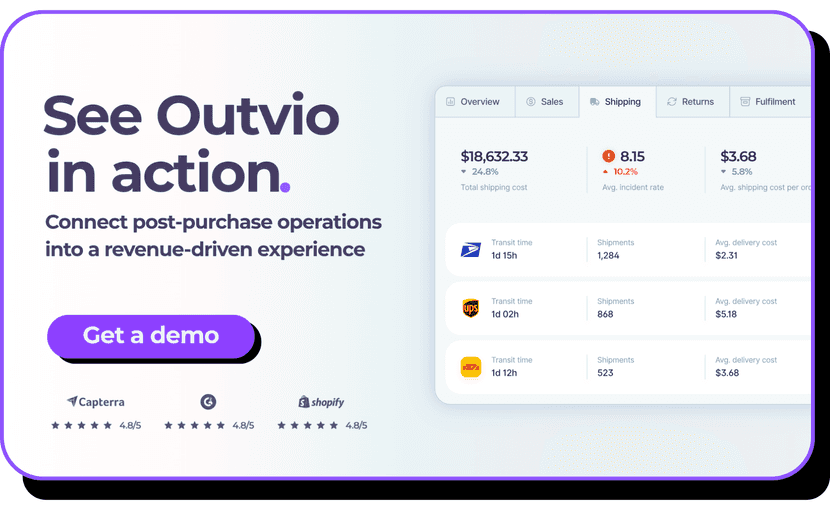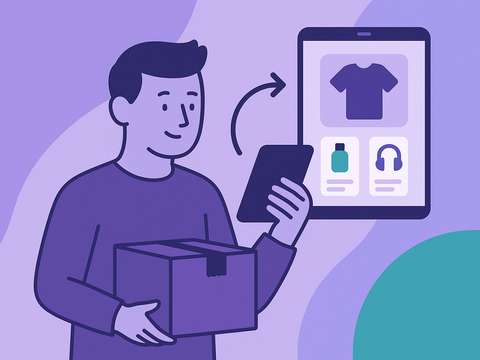TL, DR
- FedEx operational delays are internal issues, like facility overloads or technical failures. They can pause shipments and hurt customer trust
- Delays might last a few hours or even days, depending on the cause. Tracking may freeze, but FedEx keeps working behind the scenes
- If your shipment had a guaranteed delivery time, you might qualify for a refund. Just remember to file the claim within 15 days
- With Outvio, you can spot these delays in real time, resolve incidents automatically, notify your customers, and even offer compensation
FedEx operational delays can have a direct impact on your brand perception.
Customers tend to associate delivery performance with your business. A delayed or stalled shipment can lead to frustration, reduced trust, and potential churn.
In this article, we’ll explain what a FedEx Operational Delay is, what causes it, how to respond effectively using a shipping software, and what steps your business can take to minimize the risk of future disruptions.

What does FedEx operational delay mean?
A FedEx operational delay is a delivery issue that means your package is temporarily held up due to internal problems within the FedEx network, such as technical failures or logistical bottlenecks.
It’s not related to the sender, recipient, or customs.
When this status appears on a tracking update, it signifies that FedEx has identified an delivery exception and is actively working to resolve it. The affected shipment may be:
- Rerouted to bypass the impacted area or facility
- Transferred to an alternate processing center for faster handling
- Prioritized through contingency channels to reduce transit time
While real-time tracking may temporarily stall, FedEx systems continue to monitor and manage the shipment internally.
Once the issue is resolved, tracking activity resumes, and an updated estimated delivery timeframe is provided.
The most common causes include...
1. Incorrect delivery address
Packages with missing apartment numbers, wrong postal codes, or unclear recipient names are flagged for manual review. This holds the shipment until corrected, causing an operational delay.
2. Weather disruptions
Severe weather like snowstorms or floods can halt operations at hubs or along the delivery route. These safety-driven delays affect multiple shipments at once.
3. Mechanical failures
Breakdowns in sorting equipment, trucks, or aircraft can pause operations entirely. Packages are held until repairs or replacements are made.
4. Facility overload
During peak seasons, sorting centers may receive more packages than they can handle efficiently. This overload causes missed scans and delayed processing.
5. Labor shortages or strikes
Staff shortages or temporary strikes at FedEx hubs reduce processing speed. Fewer hands on deck means longer wait times for packages to move forward.
6. System or Network Issues
IT glitches or delayed system updates can block tracking info or disrupt routing. These internal tech problems briefly freeze package movement.
How long does a FedEx operational delay last?
There’s no fixed timeframe for when FedEx resolves an operational delay. That’s the frustrating part. A FedEx operational delay could clear up in a few hours, or it might take days.
It depends on what’s causing the issue behind the scenes.
If it’s something like staffing shortages or a facility backlog, it could be resolved within 24–48 hours.
But if it’s tied to something more serious (system outage, rerouting chaos, major peak season overload), expect longer delays.
What you can do:
- Track the last scan location to see where it got stuck
- If nothing changes in 24 hours, call FedEx and ask for a manual trace
- If you're a business, your customer wants answers, don’t wait for FedEx to fix it passively. Proactive communication is key
Outvio has an automated messaging system that connects directly with your carriers. When a delivery issue like a delay, failed attempt, or exception occurs, Outvio detects it in real time and triggers the right response.
Can I get a refund for a FedEx Operational Delay?
Technically, you can get a refund for an operational delay from FedEx, but it depends on the service level you used and the cause of the delay.
FedEx offers a Money-Back Guarantee (MBG) for certain services like FedEx Express, but operational delays may fall under the exceptions (especially during peak season or if the delay is due to “extraordinary circumstances”).
Here’s what you should do:
- Check your shipment type. If it had a guaranteed delivery window, you might qualify
- File the refund request within 15 days of the shipping date
- Provide tracking info and delivery details
- If you’re shipping regularly, consider automating this with a refund tool or using platforms that track delays and claim refunds on your behalf
How Outvio helps you manage and prevent FedEx delays
Operational delays with FedEx are unpredictable, but with Outvio, you're equipped to respond instantly, keep your customers informed, and even prevent many issues before they escalate.
1. Direct integration with FedEx support systems
Outvio connects directly to FedEx's backend, allowing you to monitor delivery incidents in real time and manage them from a single dashboard.
When a package encounters a problem, you can immediately access all necessary tracking data and take action without leaving the platform.
2. Automated incident resolution
Outvio’s tracking system detects anomalies that may lead to an operational delay—such as failed scans or unexpected route changes—and automatically opens a support case with FedEx.
This enables proactive resolution, often allowing the package to continue its route without ever entering a delay status.
3. Proactive customer communication and compensation
Your customers are automatically notified when a delay is detected. These branded updates maintain transparency and trust, reducing support tickets.
For longer disruptions, you can issue store credit or compensations directly through Outvio, helping protect customer satisfaction and retention.
4. Self-service support powered by FedEx integration
Outvio includes a fully integrated help desk and chatbot that connects with FedEx. Customers can resolve shipment-related queries on their own—such as delivery status, changes, or filing a claim—without involving your team.
Everything is automated and handled in one place.




